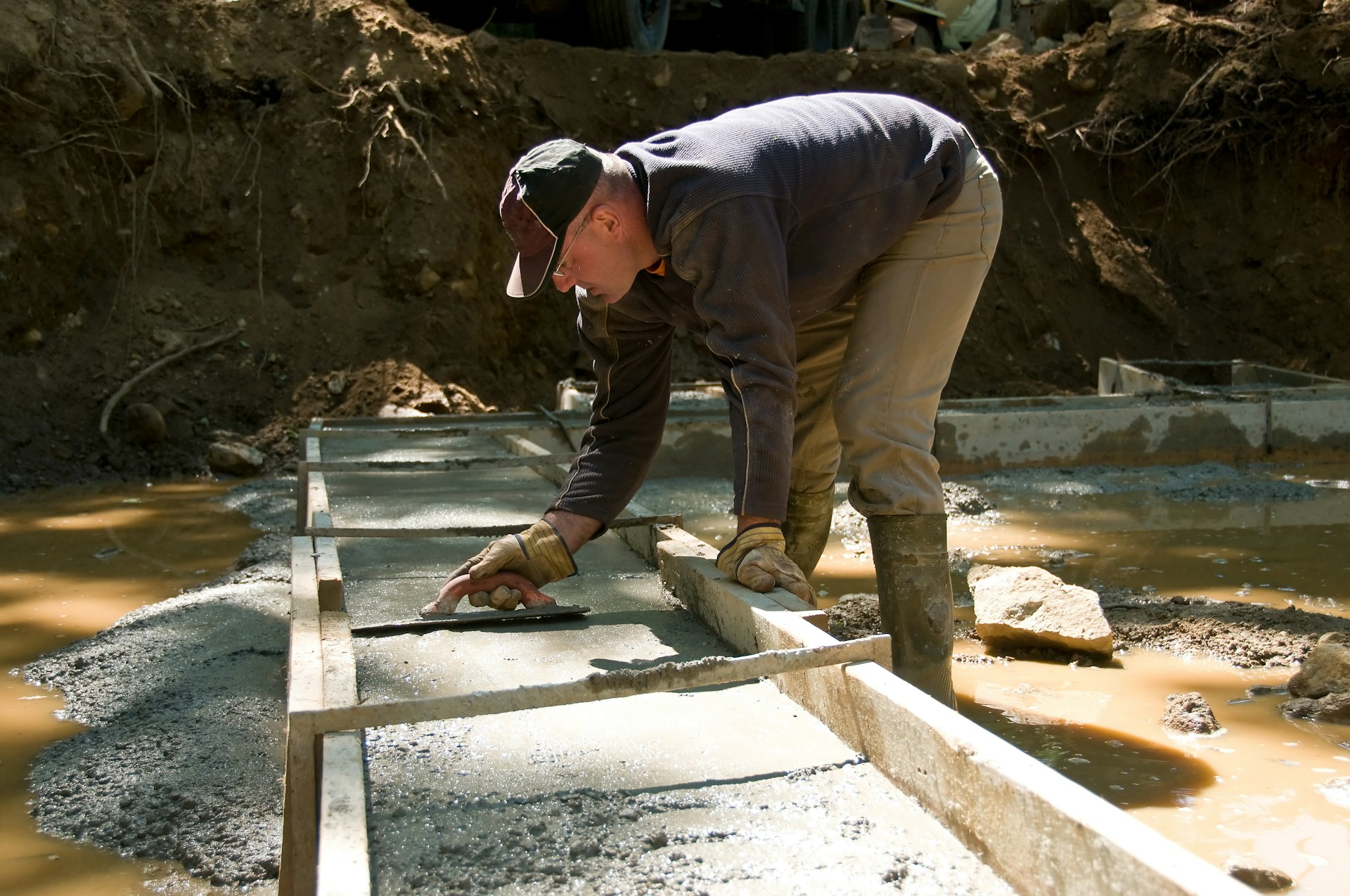Have you started noticing uneven or sunken concrete around your home or business?
Instead of ripping everything out and pouring new slabs, concrete lifting might be the better option. It’s a safe, cost-effective method that restores surface level and structural support without the mess of replacement.
At Helicon, we use polyurethane foam injection to raise and stabilize sinking concrete. The foam fills voids beneath the slab and gently lifts it back into position, all with minimal disruption to your property.
This approach not only saves time but also prevents further damage and safety risks from uneven surfaces. Whether it’s your driveway, pool deck, or patio, we make sure the repair is permanent and precise.
In this blog, we will cover:
- How concrete lifting works and when it’s needed
- The different methods and materials used to raise slabs
- Where Helicon’s solutions work best across residential, commercial, and industrial sites
Let’s dive in!
What Is Concrete Lift?
Concrete lift is fixing uneven or sunken concrete surfaces by raising them back to their original level.
It involves injecting materials beneath the slab to stabilize and support the surface. This method helps restore safety and usability to your concrete areas. Concrete lift, also called concrete raising or slabjacking, means lifting sunken concrete slabs by pushing a material below them.
The materials commonly used are polyurethane foam or stone slurry. These materials fill empty spaces, lift the slab, and solidify to create a stable base. This method avoids removing and replacing concrete, saving time and costs. It also reduces mess and damage to your property.
A properly done concrete lift can extend the life of your sidewalk, driveway, or patio while keeping it level and safe.
Common Purposes
You might need a concrete lift if your slabs have sunk due to soil erosion, water damage, or poor compaction during installation. Uneven surfaces cause tripping hazards and can damage your property’s appearance.
Concrete lifting fixes problems like broken or uneven sidewalks, driveways, patios, and pool decks. Stabilizing the ground below the concrete improves safety and prevents further damage.
Using this technique, you also help maintain your home’s structural integrity without major construction.
Types of Projects
Concrete lifting works best on residential and commercial projects with flat surfaces that suffer from sinking or shifting. Common projects include:
- Sidewalks and walkways
- Driveways and parking areas
- Patios and porches
- Pool decks
For example, Helicon uses polyurethane foam lifting to fix sinking pool decks and slabs safely. This method is non-invasive and quick, causing minimal disruption to your daily life.
Choosing the right method depends on the specific needs and conditions of your concrete surface.
Concrete Lift Methods
Wondering which lifting method is right for your concrete issue?
The truth is, not all slabs sink for the same reason, and not all ground is created equal. That’s why understanding the different lifting techniques can help you make a better decision for your home or commercial space.
Let’s break down the most common concrete lift methods, how they work, and when each is best used.
Manual Lifting
Manual lifting uses basic tools and elbow grease to raise small concrete slabs. Think pry bars, jacks, and shims, tools that are easy to find but require serious effort.
- Best for: Small areas like steps, garden paths, or pavers
- Pros: Low cost and simple tools
- Cons: Labor-intensive and often temporary
- Keep in mind: It doesn’t fix soil problems underneath, so it’s not ideal for major sinking or erosion issues.
Mechanical Lifting
This method involves machines like hydraulic jacks and lifting rigs to raise slabs with more power and precision than manual tools. It’s a strong choice for medium to large surfaces.
- Best for: Driveways, patios, or pool decks
- Pros: Controlled lifting, minimal damage risk, better precision
- Cons: Requires skilled operators and proper equipment
- Bonus: Often combined with soil stabilization for long-term results
Hydraulic Lifting
Hydraulic lifting uses pressurized fluid systems to gently and evenly lift sunken slabs. It’s reliable, accurate, and ideal for both homes and commercial sites.
- Best for: Projects requiring smooth, level lifts with minimal disruption
- Pros: High accuracy, strong lifting force, less cracking risk
- Key Feature: Allows fine adjustments to get the slab level just right
- Trusted by: Helicon uses this tech on many projects for consistent results
Pneumatic Lifting
Instead of fluid, pneumatic lifting uses compressed air to do the heavy lifting. It’s efficient, clean, and ideal for moderate-weight concrete that needs careful handling.
- Best for: Lifting smaller slabs or situations requiring precision over power
- Pros: Lightweight setup, quick operation, eco-friendly
- Cons: Not suitable for very heavy or large slabs
- Good to know: Less mess, less impact on surrounding soil
Industrial Applications of Concrete Lift
Concrete lifting plays a key role in keeping structures stable and safe across different industrial environments. It helps fix uneven surfaces, support heavy loads, and extend the life of concrete elements by addressing sinking or shifting issues.
Construction Sites
At construction sites, concrete lifting helps keep slabs level during and after building projects. Uneven or sunken concrete can delay work and create safety hazards for crews.
When soil moves or settles under slabs, lifting with polyurethane foam restores the surface quickly without removing and replacing concrete. This method minimizes downtime and lowers repair costs.
It also supports foundations, walkways, and temporary ramps, providing a stable base for ongoing work. Reliable concrete lifting is essential to maintaining project schedules and ensuring a safe environment as you build.
Infrastructure Projects
Infrastructure projects like roads, bridges, and tunnels require durable concrete surfaces that can bear heavy use. Concrete lifting in these settings corrects settled or damaged slabs that might cause cracks or instability.
Using chemical grout or foam injection, you can raise sections without shutting down large areas for long periods. This method reinforces the concrete structure and helps avoid costly full slab replacement.
Concrete lifting also fills voids under slabs caused by erosion or water infiltration. This approach improves safety for users and workers while extending the service life of vital infrastructure.
Residential Uses
In residential areas, concrete lifting fixes issues like sinking driveways, sidewalks, and pool decks. These surfaces often settle unevenly over time due to poor soil compaction or water damage.
Restoring them with foam lifting avoids tearing up landscaping or replacing large concrete sections. Concrete lifting offers a quick, non-invasive repair that improves curb appeal and prevents trip hazards around your home.
It also preserves the integrity of pool decks, which need even surfaces to remain safe and functional. When you choose a trusted provider like Helicon, you ensure that the work is done carefully and permanently, protecting your property and enhancing its value.
Equipment for Concrete Lift
Lifting concrete isn’t a one-size-fits-all job. The right tools make the process safer, more efficient, and more precise. Here’s what’s commonly used:
- Cranes and hoists are essential for moving large concrete slabs. Cranes are ideal for heavy or oversized pieces, while hoists allow controlled lifting and lowering on job sites. Both help reduce manual labor and injury risks.
- Foam and mudjacking machines are built to lift sunken concrete. Foam machines inject lightweight polyurethane foam under the slab, expanding to lift it gently. Mudjacking pumps a cement-based mixture to fill voids and raise the concrete. Hydraulic proportioners are often used for larger, heavier lifts.
- Lifting accessories include injection guns, clamps, and pads. Injection guns regulate foam flow for precision. Clamps and pads help secure the slab during lifting, preventing slips and cracks. Using trusted equipment providers like Helicon ensures reliable and long-lasting results.
Safety Considerations in Concrete Lift
Concrete lifting sounds simple, but safety should never be an afterthought. Here are the essential precautions to ensure smooth, injury-free work:
- Get Proper Training: Before using any lifting equipment, proper training is a must. Learn how to operate jacks, pumps, and foam injectors safely. Understand weight limits, tool functions, and best positioning techniques to reduce accidents.
- Inspect Equipment Before Use: Always check tools for wear, damage, or loose parts before starting. Even a small fault can lead to major risks during lifting. Trained operators know how to spot and fix issues before they become dangerous.
- Assess Load and Soil Conditions Accurately: Don’t guess the weight of your slab; measure it. Know its thickness and condition, and examine the surrounding soil for softness or instability. Misjudging this can cause the slab to crack, shift, or lift unevenly.
- Avoid Overloading or Rushing the Process: Injecting too much foam too fast or lifting more than the equipment’s rated capacity can damage your concrete or create safety hazards. Take it slow and steady; it’s safer and more effective.
- Use the Right Personal Protective Equipment (PPE): Wear gloves, hard hats, safety goggles, and sturdy footwear. These simple items can protect you from falling debris, chemical exposure, or equipment malfunction.
- Clear the Workspace: Remove unnecessary tools and obstacles that can cause trips, slips, or falls. Make sure the work area is clean, organized, and accessible at all times.
- Have a Spotter During the Lift: A second set of eyes can catch movement, strain, or shifts you might miss. Spotters help with coordination, ensure steady lifting, and can signal you to pause if anything looks unsafe.
- Prioritize Communication: Maintain clear communication with your team during every phase of the lift. Whether it’s hand signals or radios, ensure everyone is on the same page before and during the lift.
- Verify Certification if Hiring Professionals: If you’re not doing the lifting yourself, hire trained, certified professionals. Companies like Helicon emphasize skilled operator knowledge, so your project runs efficiently and safely.
- Plan Ahead for Hazard Prevention: Think through potential risks—unstable ground, heavy weather, equipment issues, and plan for them. A little planning goes a long way in avoiding injury or property damage.
Innovations in Concrete Lift Technology
New technologies are changing how concrete lifting is done, making the process safer, faster, and more precise. These advancements improve control over the lift and reduce the need for heavy manual labor.
Automation Trends
Automation is becoming a key part of concrete lifting. Machines now handle precise measurements and controlled lifting more efficiently.
Automated systems use sensors to monitor the pressure and amount of polyurethane foam injected beneath slabs. This helps maintain consistency and prevents over-lifting or damage.
Robots and automated rigs reduce the time needed for each project and lower labor costs. Fewer workers are also directly involved in the lifting process, which improves safety.
For companies like Helicon, automation supports high-quality work while minimizing risks during concrete restoration.
Remote Control Solutions
Remote control technology lets operators manage lifting equipment from a distance. This adds a layer of safety by keeping you away from heavy machinery during the process.
You can accurately adjust the foam injection and lifting height in real time. Remote controls are simple to use and allow quick responses to changing conditions on-site.
This technology is ideal for tight spaces or challenging jobs where manual control might be difficult or unsafe. With remote guidance, you stay in command while keeping your team safe and efficient.
Concrete Lifting vs. Replacement: Which Is Right for Your Slab?
Still thinking about whether lifting your concrete is the best option? You’re not alone. Some people consider tearing out and replacing the entire slab, but that’s not always necessary. Let’s compare both methods to help you understand which one fits your situation better. This way, you can make a smarter decision for your property without second-guessing.
| Feature | Concrete Lifting | Full Replacement |
| Time Required | A few hours | 2–5 days including drying/curing |
| Invasiveness | Minimal—no digging or major disruption | High—requires breaking and removal |
| Landscaping Impact | Preserves nearby landscaping | May disturb gardens, driveways, etc. |
| Structural Impact | Reinforces existing slab | Installs entirely new slab |
| Curing or Downtime | Walkable within hours | May take days to fully cure |
| Environmental Impact | Reuses materials, low waste | Produces demolition waste |
| Suitable For | Sunken but intact slabs | Severely cracked or broken slabs |
| Noise & Dust | Very low | High during demolition |
| Flexibility of Repair | Can be targeted to specific sections | Requires full slab replacement |
The Bottom Line
Concrete lifting doesn’t have to be complicated or stressful.
Whether you’re dealing with uneven walkways, sunken driveways, or poolside slabs, the right technique can restore both safety and appearance, without tearing everything apart. It’s all about using trusted methods, proper equipment, and expert guidance to get the job done right.
Helicon’s team understands Florida’s soil and structure challenges and delivers solutions that last. So instead of guessing what your slab needs, let professionals take a look and give you the confidence to move forward.
Need help deciding if your concrete should be lifted or replaced?
Reach out to Helicon today and get expert insight tailored to your property. Your safe and stable foundation starts here.
Frequently Asked Questions
Concrete lifting can feel like a big project, especially if it’s your first time dealing with sunken slabs or uneven surfaces. You might still have a few lingering questions about how it works, what to expect, and what matters most. So let’s clear up the most common doubts with some straightforward answers.
What causes concrete slabs to sink in the first place?
The most common reasons include poor soil compaction, water erosion, tree roots, and extreme weather changes. These factors weaken the ground under the slab, leading to settlement over time.
Is concrete lifting a permanent solution?
Yes, when done properly with quality materials like polyurethane foam or cement slurry, it can offer long-term stability. However, future soil movement or water issues can still impact the results if they are not addressed.
How soon can I use the area after concrete lifting?
Most polyurethane foam methods can be used within 15 to 30 minutes. Depending on the mix used and weather conditions, mudjacking may require several hours to cure.
Can I lift cracked concrete?
Yes, minor cracks don’t stop lifting. In fact, lifting can close small gaps. However, large or structurally compromised slabs might need repair or replacement first. Professionals will assess if lifting is viable.
Is concrete lifting eco-friendly?
Polyurethane foam is considered eco-friendly because it uses fewer materials, reduces waste, and avoids full slab replacements. It also limits disruption to your landscaping and avoids landfill contributions.
Will lifting damage nearby landscaping or utilities?
No, a professional team maps out utility lines and uses small injection holes, so the impact is minimal. Landscaping is usually untouched unless heavy machinery needs access.
How do I know if lifting or replacing is the better option?
If the slab is in good condition but uneven, lifting is the smarter, cost-effective choice. Replacement is better for slabs with severe cracking, crumbling, or foundational damage beyond repair.





